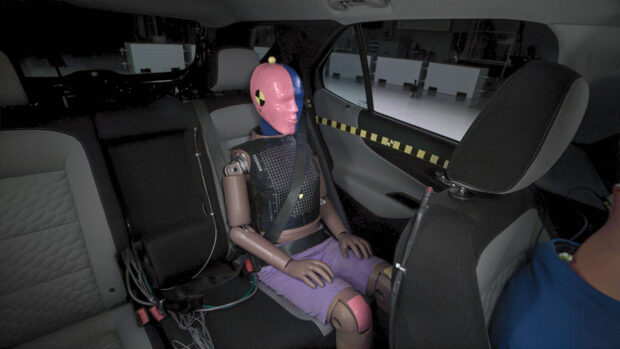New scoring criteria is being rolled out for the Insurance Institute for Highway Safety’s moderate overlap front crash test to better account for variations in the position of the rear shoulder belt.
A new metric called the chest index factors in both the position of the shoulder belt on the rear dummy’s chest and chest compression, the safety organization said.
The belt position itself is also evaluated as part of a holistic analysis of how well the restraints control the motion of the dummy during the crash.
The range of shoulder belt positions considered acceptable has been expanded slightly, the IIHS added.
Previously published ratings in the updated moderate overlap test, which was launched in 2022, have been adjusted on the Institute’s website in conjunction with the change.
The ratings of five vehicles improve, and eight receive downgrades.
“Most of these changes are part of a planned transition that we informed automakers we’d be making before we launched the updated test a year ago,” said Jessica Jermakian, IIHS vice president of vehicle research. “The new scoring eliminates an artificial benefit our initial ratings awarded for a high shoulder-belt position. Pressing ahead with a simpler program while we validated the new metric allowed us to start incentivizing vehicle improvements a year earlier.”
The moderate overlap front test was launched in 2022, after research showed that in newer vehicles the risk of a fatal injury is now higher for belted occupants in the second row than for those seated in front.
The back seat remains the safest place for children and the rating does not apply to children secured properly in child safety seats, said the IIHS.
In the updated test, a dummy the size of a small woman or 12-year-old child is positioned in the second row behind the driver dummy.
For a vehicle to earn a good rating, there can’t be an excessive risk of injury to the chest, among other body regions, as recorded by the second-row dummy.
For the initial year of testing, IIHS engineers estimated the risk of chest injuries with a device that records the seat belt tension and the dummy’s own chest deflection sensor — measuring how much the rib cage is compressed by the force of the crash, the IIHS explained.
A pressure mat was used to track the position of the shoulder belt and penalized vehicles when it exceeded a maximum height to avoid a delay in the release of the test.
Vehicles with shoulder belts higher than the cutoff could receive no better than a marginal rating for chest injury risk, regardless how little chest deflection the dummy’s internal sensor recorded, the IIHS noted.
The new chest index takes into account both chest deflection and belt position, using a formula the IIHS said it has been validating for the past year to adjust the deflection metric based on distance of the shoulder belt from the internal sensor.
While the pressure mat is still used to determine the maximum shoulder belt position during the crash, engineers now evaluate maximum belt position separately as part of their assessment of how well the restraints control the motion of the dummy during the test, which reduces the influence of shoulder belt height on the overall rating.
The cutoff for a belt that is too high has been raised by 10 millimeters in recognition of the need for shoulder belts to accommodate occupants of various sizes, the IIHS said.
The belt tension metric, which makes it very difficult for a vehicle without technology like pretensioners and belt force limiters to earn a good rating, remains unchanged.





















 What to Expect in 2026: U.S. P/C Results More Like 2024
What to Expect in 2026: U.S. P/C Results More Like 2024  Artificial Intelligence Is Rewriting the Rules for Commercial Lines
Artificial Intelligence Is Rewriting the Rules for Commercial Lines  Why Insurance Telematics Integrations Fail
Why Insurance Telematics Integrations Fail  Unpacking a Consumer Intervenor’s Novel Idea
Unpacking a Consumer Intervenor’s Novel Idea 